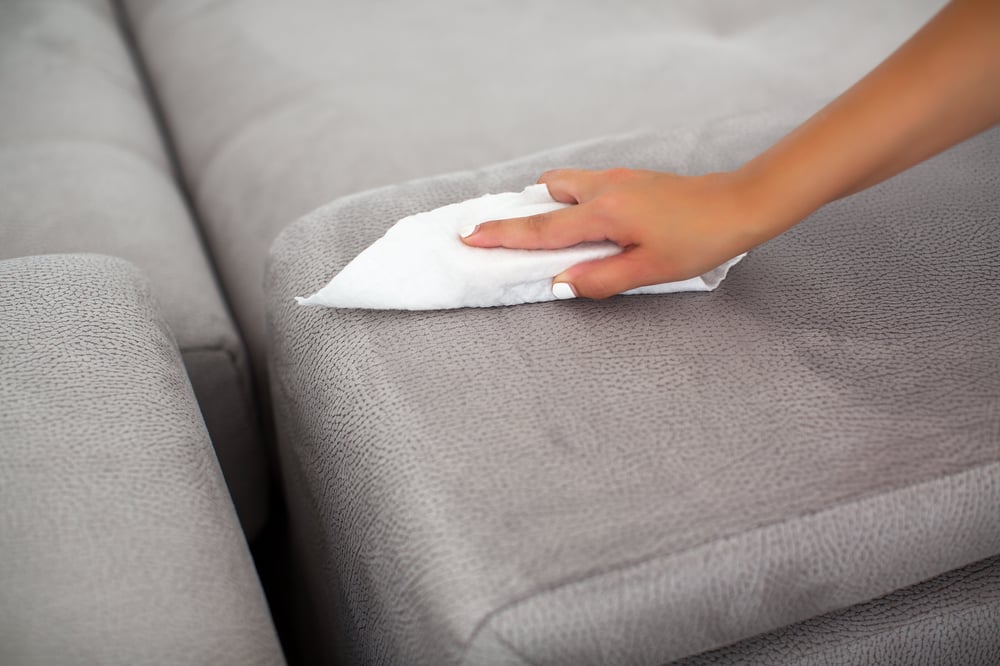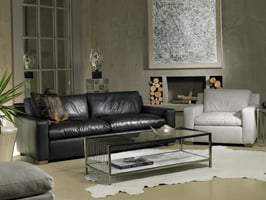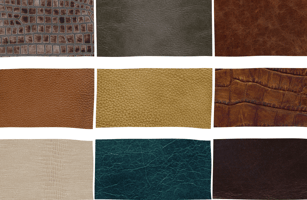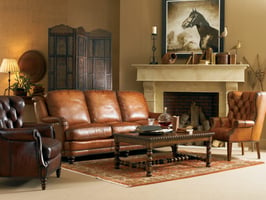There was absolutely a time when leather was the hands-down, second-to-none, choice for upholstery...
Leather Furniture Maintenance: How to Care for Top Grain Leather
Leather furniture seems to be that perfect mix of luxury and durability – that’s what makes leather such a popular choice for furniture upholstery. You’ve seen the benefits of top grain leather on your own furniture already and now you just want to make sure you can keep it looking its best for as long as possible!
Taking care of your top grain leather, well, it’s kind of a funny thing. Just in the sense that, of course, you want to look after it, but you also want your leather to maintain that natural charm you fell in love with in the first place! The ruggedness and (ready for a fancy term here?) patina is part of what makes leather so appealing.
Patina, by the way, is the weathered look that leather takes on as it ages – kind of like a fine wine.
Since we opened in 1994, McElheran’s Furniture + Design has always offered high-quality upholstery for custom furniture orders – including a wide selection of top-grain leather. But you already have your perfect piece of leather furniture, don’t you? We’ll definitely be here when you want to make your next furniture purchase, but for right now, we just want to make sure that you get the most out of the leather furniture you have!
In this article, our in-house designers, known as Design Guides, will take you through the regular maintenance of top grain leather. We’ll also touch on extending the life of your leather pieces, and any external elements you should be aware of that could affect your leather’s longevity.
And before we get into it, we should also say that caring for your leather furniture is not meant to be labour intensive. The last thing we want you to feel is that you have to put so much work into the upkeep of your top grain leather – it’s simply not the case!
Your furniture is meant to be enjoyed, right? These maintenance tips are just little things you can do here and there to ensure you will enjoy your leather furniture for many years to come.
What regular maintenance should I be doing with my top grain leather furniture?
Most leathers, especially the more naturally coloured ones, have to get reasonably dirty before it’s obvious – which is definitely a positive when it comes to leather.
However, when we don’t see dirt and grime, we’re less likely to clean something. Because of that, leather maintenance is not done nearly as often as it should be.
So, don’t wait around for the dirt and dust to show – it’s better to regularly wipe down and look after your leather furniture!
Dust your furniture
Taking a duster or a dry, microfibre cloth and running it over your furniture is a quick and virtually effortless way to remove any dirt, debris, or any other particles that may have built up over time.
Vacuum your furniture
Once you’ve dusted and removed most of the debris, a quick vacuum could give your furniture an even deeper clean. It’s best to go about vacuuming your leather with the curtain attachment (the one with a lint-catching fabric strip), as opposed to a heavy-duty beater bar. We cannot stress enough that you should never use that kind of attachment on your leather furniture.
Wipe with a damp cloth (if applicable)
To take care of any unwanted spots or build-up from the natural oils of those using your furniture, you could use a dampened cloth - just be aware of the type of top grain leather you’re dealing with first.
With protected leather (like aniline plus and pigmented leather), taking a cloth and moistening it with water or a mild Ivory soap and warm water solution should be fine. John Hayden of Hancock & Moore suggests using this solution every few months on the headrests and arms of your leather furniture. Those areas tend to be used and touched more, leaving behind natural oils that can build up on your furniture.
Then, run a clean and dry cloth over your furniture to dry away any excess moisture.
Now, with unprotected leather (pure aniline, semi aniline, and nubuck) it’s best just to stick with dry methods of cleaning, like dusting and a gentle vacuum.
You don’t want to expose your unprotected leather to moisture because it can matte the fibres and ruin the “hand” of the leather. Hand is, essentially, how the leather feels. And what makes some leathers, like nubuck, so appealing is how soft it is to the touch.
Check for spots and stains
While you’re wiping your furniture down, you might as well give it a good look over! It’s really the perfect time to catch a little stain before it turns into a bigger problem.
Condition your top grain leather
In this harsh Edmonton climate, it can get very dry in the winter. And keep in mind that leather is basically skin, right? And if your skin is starting to feel dry and itchy, it may be time to condition your leather furniture, too.
We would recommend using the Guardsman Leather Conditioner twice a year. If it helps, think about conditioning your top grain leather every time we change our clocks for daylight savings.
What else can I do to extend the life of my leather furniture?
Change up “your spot”
We all do it because we’re creatures of habit. We find that perfect place on our sofa or our favourite chair and it becomes “our spot.”
And it’s your furniture, we’re not going to tell you how to use it. But for the sake of your leather’s longevity, it wouldn’t be the worst thing if you switched up your spot every once in a while. Sitting in different seats and occasionally fluffing up your cushions will keep any wear-and-tear consistent with the rest of your furniture or other matching pieces.
Read up on the warranty of your furniture
There may be some care and maintenance recommendations under your leather furniture’s warranty. It’s also good to know the guidelines of your warranty before you take any sort of major action into your own hands.
Additionally, your warranty could become void if you use cleaning agents that are not recommended.
Be careful of what’s in your pockets
Hey, we’ve seen it happen – and it’s always an accident, of course! Leather can be punctured by sharp or jagged items left in your pockets.
Before you sit down on your leather furniture, think about what you might be carrying with you.
Nine times out of ten, your top grain leather furniture will be able to withstand some pressure from keys or pens in your pockets, but it only takes that one time for you to realize how damaging sharp objects can be to your leather furniture!
Lay down blankets or use headrest covers
We all have natural oils in our hair and skin, which can transfer onto furniture. And over time, these oils can damage leather – especially with overuse.
It never hurts to occasionally throw on a blanket or headrest cover on your furniture. It can add an extra layer of protection from excess moisture or oil. And hey, that throw blanket or headrest can even double as an accessory!
Why do I have to look after my top grain leather?
One of the appeals of leather - especially the quality you’re getting with top grain – is that it’s very durable and relatively low maintenance. In fact, that’s one of the biggest reasons why anybody invests in leather furniture! So, if it’s so durable, why even bother with any sort of upkeep?
Apart from the fact that looking after and caring for your leather can extend its life (as with most things), you’ll also keep your furniture looking like new, longer.
And it’s never a bad thing to get in the habit of taking care of your leather furniture. Once you do that, you’ll find that you’re more in tune with seeing potential issues, like spotting stains before they get worse!
These are investment pieces, right? A little maintenance here and there will go a long way and prevent you from having to replace your leather furniture more often than you really should.
External factors that can affect the life of top grain leather
Top grain leather should be able to withstand regular, daily use, but there are a few external elements that can add some extra wear to your furniture. These are just a few things to be mindful of, so you can get the most life out of your top grain leather pieces!
Heat and dryness
Again, here in Edmonton, we have a bit of a tricky climate going from extremely hot to extremely cold. But one thing is pretty consistent up here: it can be very dry.
It shouldn’t be too much of an issue inside your home, but if your place happens to be quite dry, your top grain leather could suffer. Especially if you’re not keeping up with conditioning your leather, it could become brittle and rather delicate.
Positioning your leather furniture close to a strong source of heat can exacerbate this drying issue, too. It is recommended that you should maintain at least two feet between your furniture and heating sources.
Sunlight
All materials will fade over time when exposed to direct sunlight, and top grain leather is no different. If you can, move your furniture away from windows or perhaps close your blinds during the hot and sunny hours of the day.
Pets
We promise that we have nothing against pets – far from it! But the truth is, they can affect the longevity of your furniture. Their claws can puncture leather or leave scratch marks, they can track in dirt and debris, or even chew up pieces of your furniture.
Dye transfer
There are few things in life that measure up to that feeling of finding a perfect new pair of jeans. And while you should enjoy your new clothes, just be aware that they could leave a lasting impression on your top grain leather.
This is mainly a concern for leather furniture that’s on the lighter side, like a white or light grey. Your pants deeply saturated in a dark dye could transfer onto your furniture after time – especially if you’re sitting in the same spot, wearing those same pants day after day.
Should I continue to invest in leather furniture?
Leather has always been associated with quality – and for good reason! Leather furniture has a lot to offer a home and, as you can tell, the level of upkeep is pretty minimal.
So yes, leather, especially top grain leather, is a worthy investment. However, there are other options out there if you’re looking to change things up without compromising on quality. Check out Leather Furniture: Is it Really the Best? (Benefits, Problems, and Alternative Options) to see what other upholstery could work for your future purchases.
And if you’re in the neighbourhood, drop by the showroom! Our Design Guides look forward to answering any questions you may have about top grain leather. And when the time is right and you’re looking for that next piece of furniture, we’d be more than happy to assist you.


-min.png?width=1000&name=Untitled%20design%20(12)-min.png)

-min%20(1).png?width=1000&name=hancock(test)-min%20(1).png)


